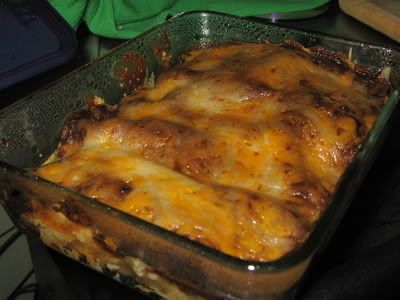This was my first
Daring Bakers challenge, and I lucked out because it was the perfect thing to bring to a barbecue/potluck, which we happened to be having in August for work. Though the challenge allowed us a bit of freedom in personalizing the recipe, I decided to make them just as the recipe suggested -- with chocolate pastry cream and chocolate glaze. My coworkers are chocolate fiends, and I was depending on them to eat all or at least most of the eclairs, as I didn't want to have to eat them all myself!
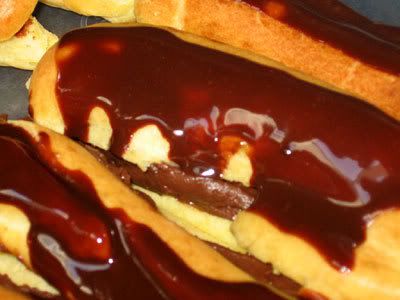
The barbecue was on a Friday, and I don't have the luxury of being able to take a day off from work just to bake (more's the pity), so I made of the components (the chocolate sauce and chocolate pastry cream) in advance, as suggested by the recipe. I didn't find that doing so detracted from their flavor at all.
Even though there are seemingly a lot of steps to eclair making, it's actually quite simple and not that time consuming (except for having to wash everything afterward, of course). The part I was most nervous about was the cream puff dough, which The first snag I had on that front was that I wasn't able to find a 2cm tip. That's fairly large, and all the stores carry are decorating tips, which are a fraction of that size. I even went all the way to freaking Sur la Table! I ended up having to improvise with a regular plastic food bag.
Step-by-Step Pictorial: Chocolate Eclairs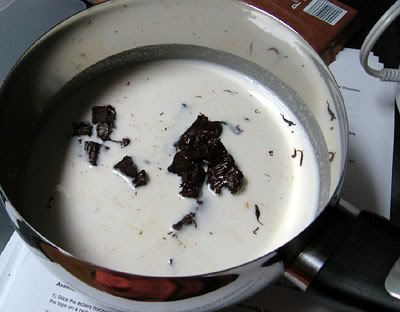
I made the least "important" component first, because it was the easiest. Here's the prep for the chocolate sauce, which is an ingredient that goes into the glaze. Here's heavy cream, sugar, chocolate, and water added together in a pot, about to be boiled.
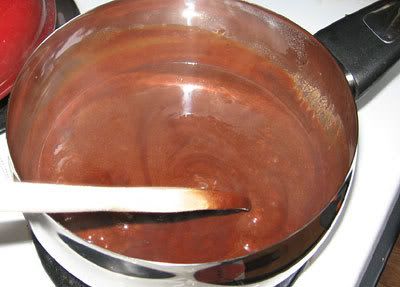
Here it is after the first boil + 15 minutes. It's thickened enough that it should be ready now.
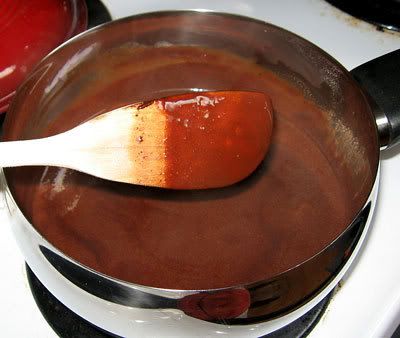
It's coating the back of my wooden spoon, as the instructions say, so yep, it's ready! At this point I poured it into a large mug to cool. I kept it in the fridge for about 3 days, after which time I warmed up a bit to use in the final glaze.
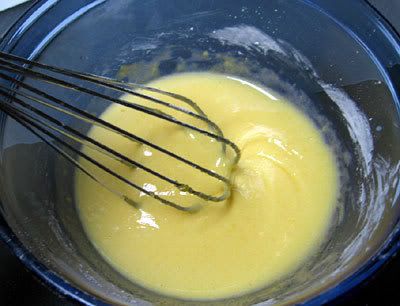
Here's a mixture of 4 egg yolks, sugar, and corn starch while 2 cups of whole milk are heating up on the stove. This will eventually become pastry cream.

A couple of spoonfuls of boiling hot milk have been added to the egg mixture to "temper" it. This raises the temperature slowly and will prevent the eggs from curdling (and making scrambled eggs!), as would probably happen if you just added all the hot milk at once.
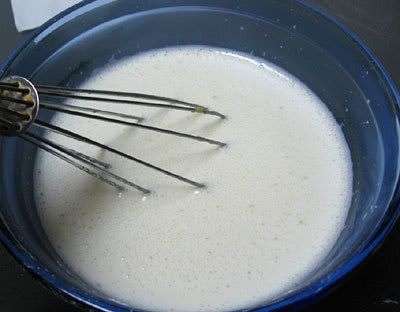
All the hot milk has been added to the yolk mixture.
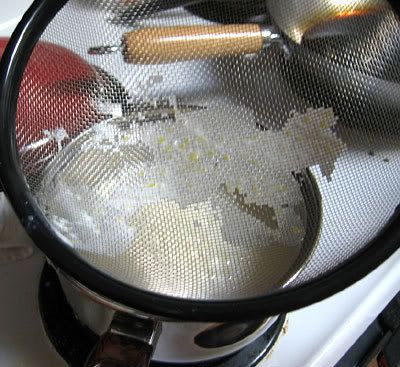
The milk/yolk mixture is strained into the saucepan to remove any bits of egg that's been curdled. I actually think I managed to avoid that. The bits in the strainer are unmelted yolk/sugar I think. Or... okay, maybe it's tiny pieces of scrambled egg, who knows.
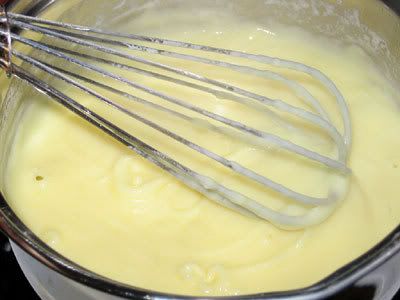
After bringing the milk/yolk mixture to a boil, this lovely pastry cream is what it becomes. I was amazed to see it happen so quickly and beautifully.
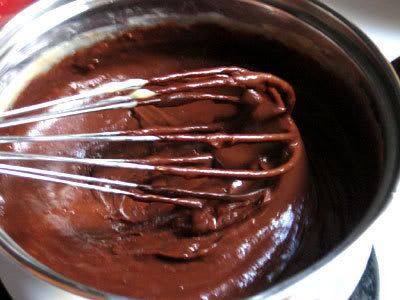
Here I've added melted chocolate to the pastry cream, thus making it chocolate pastry cream. Wild, I know.
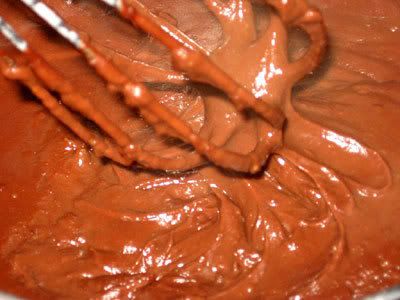
EXTREME CLOSE UP!!!
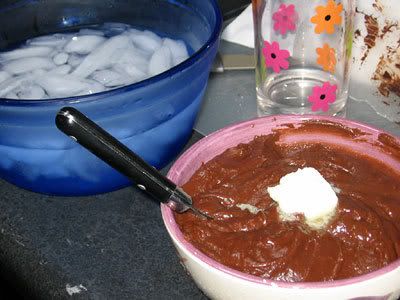
Here the pastry cream has been cooled to 140°F with an ice water bath (which you see pictured), and I'm mixing butter into it.
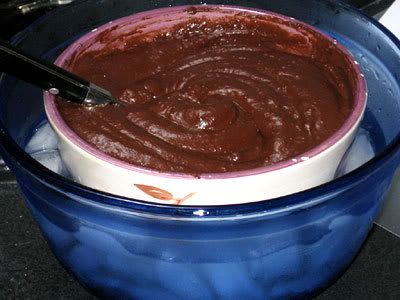
After adding the butter, the pastry cream cools to room temperature via the ice water bath. At this point it's going to be stored in the fridge until it's time to fill the eclairs with it. I was 'forced' to eat a spoonful when I had to take the spoon out and it was delicious.
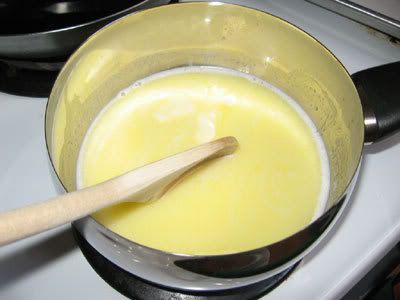
So the morning of the BBQ, I prepared the cream puff dough and the chocolate glaze, and suffered through a conference call that was more than an hour long. But I digress. Here I've brought some whole milk, water, sugar, salt, and butter to a boil.
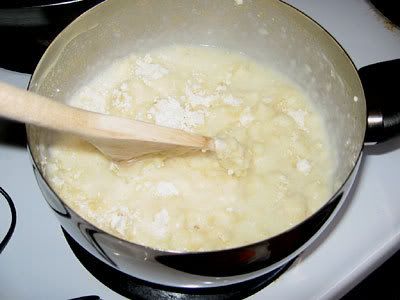
Added 140g of flour to the boiling mixture, resulting in this clumpy, unappetizing mess. Just a note that I weighed my ingredients where weight measurements were provided. It's much more accurate than volume measurements, and I need all the help I can get.
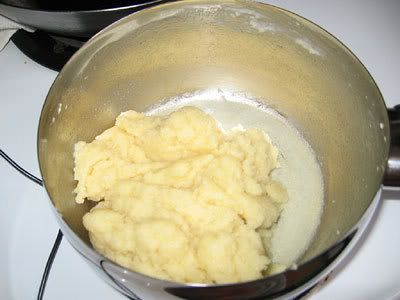
After 3 minutes of stirring, the dough has come together and is ready to be placed in the mixer for the addition of the eggs. A slight crust forms at the bottom of the pan during this step, which is to be expected.
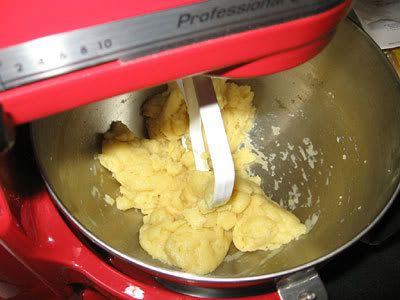
Here's the dough after the addition of 1 egg. It separates a bit, as you can see.
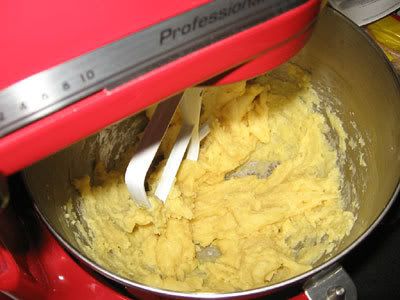
After 3 eggs, it's starting to come together a little more.
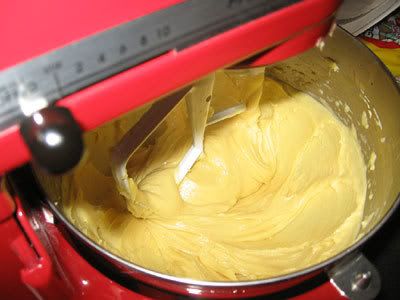
Here's the dough after the 5th and final egg, and a couple minutes of extra mixing (to get the consistency to match what the instructions say, that the dough should fall back into the bowl in a ribbon when lifted).
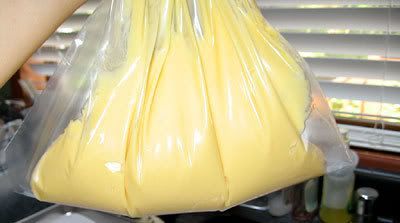
I then scraped the still-warm dough (very important) into my makeshift pastry bag, which was just a large freezer bag with a hole cut into one of the corners.
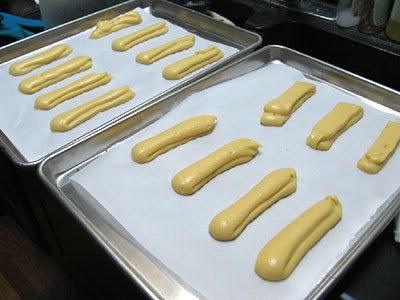
I lined two baking sheets with parchment and made notations on each for 4 1/2-inch sections where the eclairs would be. The piped dough came out more like a ribbon instead of a chubby finger, so what I did was just go back over the first layer of piped dough with another layer. It worked decently well for being a makeshift thing.

Baked as instructed. There was one part where the instructions weren't clear though. You're supposed to put them in the oven and let them bake for 7 minutes, then stick a wooden spoon in the oven door to keep it slightly open for another 5 minutes for a total of 12 minutes. After that you're supposed to switch the trays from top to bottom and front to back, then bake for an additiona 8 minutes, but it doesn't say whether you're supposed to keep the door slightly ajar as you were doing right before, or go back to having the oven door fully closed. I learned from my bread experiments that doing so dries out the bread (or in this case pastry), and since eclairs/cream puffs are generally drier from what I recall, plus there would be pastry filling, I opted to keep the door ajar. At the first switch, the eclairs that were on the upper shelf had puffed much more than the ones on the bottom. After the full baking time, the ones that had been switched to the top were puffy while the ones on the bottom were flat. I'm not sure what I could have done to prevent this.

It didn't matter that much though, because after awhile even the puffy ones deflated quite a bit. I also don't know what to do to prevent that either! Also, I don't know if you can tell from the pictures, but they weren't that big. They were like, mini-eclairs. Also, I ended up piping around 14 eclairs at a length of 4 1/2-inches each. The instructions say that there should be enough dough for 20-24 eclairs. So I don't know if those eclairs puff up much bigger than mine did, or if they're meant to be small.
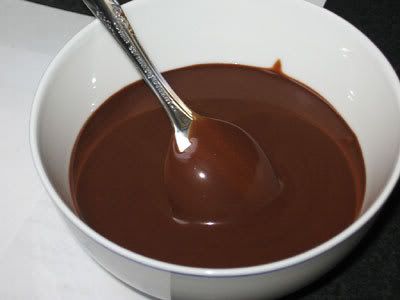
Here's the chocolate sauce I made in advance.
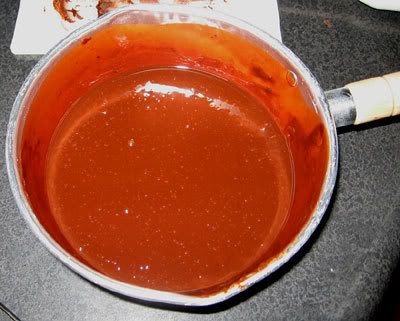
I added the chocolate sauce to some more chocolate, butter, and heavy cream, and that created this glaze. The flash kind of ruined this shot. ><
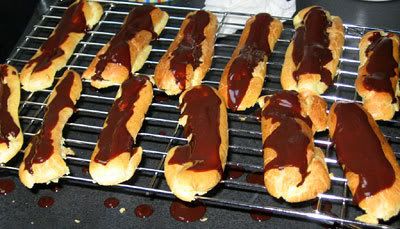
Hmm, I guess I should have used parchment paper on the wire rack as suggested in the recipe, as the glaze was really ... drippy.
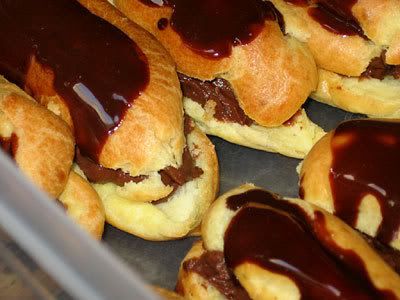
Filled the bottoms with previously made chocolate pastry cream and gingerly dropped the still-wet tops on them.
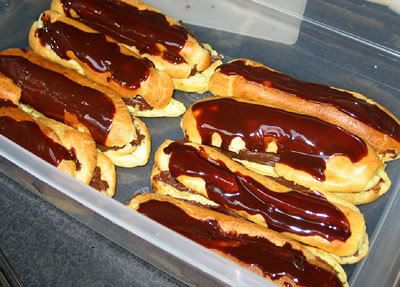
It would have been helpful if the instructions had said how long it would take the glaze to cool, because it definitely took awhile. The tops were still wet when I put them together. However, it took me about an hour to get to the BBQ, so they were drier by then.
I tried one to make sure it was edible and wouldn't be subjecting people at the barbecue to eclair rocks. The cream puff dough I thought tasted a bit eggy, but the chocolate covered that up pretty well. The chocolate pastry cream/glaze were both very good. And I was actually glad that they were miniature size, because eating a mini-eclair is much more acceptable than eating a normal-sized one.
They were a hit at the party (or everyone was being very polite). They all pretty much disappeared, and my manager even asked if I had made the dough myself and how I'd done it. Yay for chocolatey baked goods!

